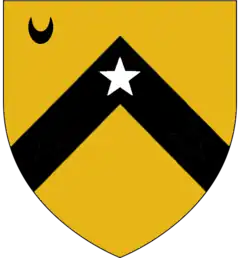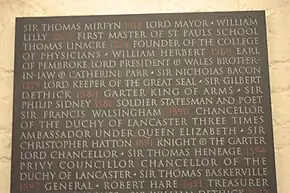Thomas Murfyn
Thomas Murfyn (or Mirfyn, Merfyn, Murphin), (died 1523) was a Sheriff and Lord Mayor of London.[3]
Thomas Murfyn | |
|---|---|
 Coat of Arms of Thomas Murfyn: Or on a chevron sable a mullet argent. A crescent sable in the dexter chief.[1] | |
| Lord Mayor of London | |
| In office 1518–1519 | |
| Monarch | Henry VIII |
| Preceded by | Sir Thomas Exmewe |
| Succeeded by | Sir James Yarford |
| Sheriff of London | |
| In office 1511–1512 | |
| Preceded by | John Rest |
| Succeeded by | John Brydges |
| Personal details | |
| Born | Ely, Cambridgeshire |
| Died | September 1523[2] London, UK |
| Resting place | St Paul's Cathedral, London, UK 51.513611°N 0.098056°W |
| Spouse(s) | Alice Marshall Elizabeth Donne |
| Children | Edward George Margaret Mary Frances, and others |

Biography
Thomas Murfyn was a native of Ely, Cambridgeshire, and son of George Murfyn. He was a member of the Worshipful Company of Skinners in the City of London, who served as Sheriff of London from 1511 to 1512, and as Lord Mayor of London from 1518 to 1519.[3][4]
Mark Noble claimed that Murfyn was probably not knighted until after his election to the mayoralty.[5] Although Murfyn is often referred to in later documents as Sir Thomas Murfyn, there appears to be no record of his knighthood.[6] It became common practice after Thomas Muryfn's mayoralty for Lord Mayors of London to be knighted and this may be one reason why later documents refer to him as "Sir".[7] The misunderstanding may also be due to the translation of the form of address "Dominus" (a term of courtesy used in reference to an official) as "Sir". In his will, which was made on 2 September 1523 and proved in London on 15 October 1523, Murfyn refers to himself as "Thomas Mirfyn citizein and Alderman of the citie of London".[8] The memorial to the graves lost in the Great Fire of London at St Paul's Cathedral, which lists "Sir Thomas Miryfn", may be perpetuating this error rather than evidence of a knighthood.
Family
Thomas married firstly, Alice Marshall,[9] by whom he had thirteen children:[10]
- Thomas
- John
- George, who became a monk
- Thomas
- John
- Frances
- Richard
- John
- Robert
- Edward (d. 1528),[11] a wealthy London merchant who married Alice (d. 1560), widow of John Brigandine of Southampton, and daughter of Oliver Squier of Southby, Hampshire, by whom there were no surviving children. Alice subsequently married, circa 1528, Edward North.[12]
- Bartholomew
- Margaret, who married a Lord Mayor of London, Sir John Champneys.[13][14]
- Mary, who married, by 1523,[15] another Lord Mayor of London, Sir Andrew Judde.[16]
He married secondly, sometime after 15 October 1519,[15] Elizabeth, only daughter and heiress of Sir Angel Donne. alderman of London, and Anne Hawardine, of Cheshire. By Elizabeth, he had a daughter:
- Frances (c.1520/1–c.1543),[17] who married Thomas Cromwell's nephew, Sir Richard Cromwell by 8 March 1534.[18]
His last wife survived him and subsequently married, in 1524, Sir Thomas Denys[18] by whom she had a son, Sir Robert Denys. Sir Robert married Mary, daughter of William Blount, 4th Baron Mountjoy, by whom he had a son, Thomas Denys.
The arms of the Murfyns were, Or on a chevron sable a mullet argent; those of Donne, Azure semée of cross-crosslets or, a unicorn salient argent.[19]
Mirfyn is listed as one of the graves lost in the Great Fire of London in 1666, on a monument in the crypt of St Paul's Cathedral, together with several other Lord Mayors.
Notes
- Lambarde 1931, p. 100.
- Murfyn's will was made on 2 September 1523 and proved 15 October 1523. See Beaven II 1913, p. 22 The Testator was recorded as Thomas Mirfyn citizen and Alderman of the city of London. See Drake 1873, pp. vi–viii
- Noble 1787, p. 19.
- Beaven II 1913, p. 22.
- Noble 1787, p. 19
- Beaven II 1913, p. 22, fn 30.
- Noble 1787, p. 19: John Stow in the year 1519, observed that after that time it was usual to knight the lord mayor when elected.
- Drake 1873, pp. vi−viii
- Lambarde 1931, p. 99.
- Only four of Thomas Murfyn's fourteen children: Thomas, John, George, Thomas, John, Frances, Richard, John, Robert, Edward, Bartholomew, Margaret, Mary by Dame Alice and Frances by Dame Elizabeth, were beneficiaries of his will. See Drake 1873, pp. vi-viii
- Will dated 3 March 1527, proved 11 May 1528. See Drake 1873, pp. viii–ix
- Carter 2015.
- Vere-Hodge 1953, p. 30.
- Betteridge 2006.
- Drake 1873, pp. vi–viii.
- Slack 2008.
- Fitzgerald 2019.
- Hofmann 1982.
- Noble 1787, p. 19 cites Lives of Oliver lord protector. Chronicles of Hall, Fabian, and Grafton, Stow's survey of London, Fuller's worthies. Visitation of Huntingdonshire, in 1613, given in the Harl, M.S.S. vol. 1179.
References
- Beaven, Alfred B. (1913). The aldermen of the city of London. Vol. II. London: Corporation of the City of London. Retrieved 20 October 2019.
- Betteridge, Tom (September 2006) [First Published 2004]. "Champneys, John". Oxford Dictionary of National Biography (online ed.). Oxford University Press. doi:10.1093/ref:odnb/5096. (Subscription or UK public library membership required.)
- Carter, P. R. N. (28 May 2015) [First Published 23 September 2004]. "North, Edward, first Baron North". Oxford Dictionary of National Biography (online ed.). Oxford University Press. doi:10.1093/ref:odnb/20300. (Subscription or UK public library membership required.)
- Drake, William R. (1873). Fasciculus Mervinensis, Being Notes Historical, Genealogical, and Heraldic of the Family of Mervyn. London. Appendix I. pp. vi–viii. Retrieved 19 October 2019.
{{cite book}}: CS1 maint: location missing publisher (link) - Fitzgerald, Teri (18 August 2019). "All That Glitters: Hans Holbein's Lady of the Cromwell Family". queenanneboleyn.com. Retrieved 19 October 2019.
- Hawkyard, A. D. K. (1982). "North, Edward (c.1504-64), of Kirtling, Cambs., the Charterhouse, Mdx. and London". In Bindoff, S.T. (ed.). The History of Parliament: the House of Commons 1509-1558. Boydell and Brewer.
- Hofmann, T. M. (1982). "Cromwell, alias Williams, Richard (by 1512-44), of London; Stepney, Mdx. and Hinchingbroke, Hunts.". In Bindoff, S.T. (ed.). The History of Parliament: the House of Commons 1509-1558. Boydell and Brewer.
- Lambarde, Fane (1931). "Sir Andrew Judde" (PDF). Archaeologia Cantiana. Kent Archaeological Society. 43: 99–102.
- Noble, Mark (1787). Memoirs of the Protectorate-house of Cromwell: Deduced from an Early Period, and Continued Down to the Present Time... Vol. 1 (3 ed.). London: C. G. J. and J. Robinson.
- Slack, Paul (3 January 2008) [First Published 23 September 2004]. "Judde, Sir Andrew". Oxford Dictionary of National Biography (online ed.). Oxford University Press. doi:10.1093/ref:odnb/37622. (Subscription or UK public library membership required.)
- Vere-Hodge, H. S. (1953). Sir Andrew Judde, Lord Mayor of London 1550-1551, Mayor of the Staple of Calais, six times Master of the Skinners Company, Founder of Tonbridge School 1553. Tonbridge School Shop.
- Wadmore, J. F. (1881). "Some Account of the History and Antiquities of the Worshipful Company of Skinners, London". Transactions of the London and Middlesex Archaeological Society. London: J. H. & J. Parker. 5: 92−182. Retrieved 12 May 2020.
External links
- Attribution
 This article incorporates text from this source, which is in the public domain: "Memoirs of the Protectorate-house of Cromwell: Deduced from an Early Period, and Continued Down to the Present Time,...", by Mark Noble (1787)
This article incorporates text from this source, which is in the public domain: "Memoirs of the Protectorate-house of Cromwell: Deduced from an Early Period, and Continued Down to the Present Time,...", by Mark Noble (1787)